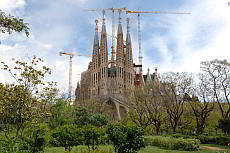Salvador Dalí
One of the main representatives of Surrealism
"Every morning when I wake up, I experience an exquisite joy —the joy of being Salvador Dalí..." This self-centered statement came from the Catalan, addicted to glory and gold, who had painted a lot and talked a lot. His favorite topic: How to become a genius. His conclusion: "Oh Salvador, you know it now, if you play the genius, then you become one!". His megalomania knew no bounds.
Salvador Dalí is one of the most popular artists in the world, made famous by his decadent lifestyle, his mustache, his provocative attitudes and his bizarre, surrealist images.
The artist Salvador Dalí, his real name is Salvador Felipe Jacinto Dalí i Domènech, was born in 1904 in Figueras (north of Catalonia). His parents had given him the name Salvador "the savior" because in their opinion he was destined to become a rescuer of painting. The threat of abstract art or academic Surrealism to Dadaism and all other anarchies he should blend with his art.
Salvador Dali's childhood and adolescence
His parents idolized him and read every wish from his eyes. He was the unrestricted ruler of the house and a chronically spoiled child. From 1921-1926 he studied at the Art Academy in Madrid. Until 1927, his works show the influence of French Cubism and Italian Futurism. He is also inspired by 17th century Dutch painting. In addition, Salvador Dalí is working intensively on Sigmund Freud's theories of psychoanalysis. In 1927, the painting "Honey is sweeter than blood", which Dalí's development to surrealist painter announced.
Reveries in school time.
Dalí came from a family of storytellers who glossed over their origins to impress. Following the family tradition, Dalí designed his own mythology and re-decorated his childhood with color, intrigue and gloom. The school performance was therefore rather bad, as he preferred dealing with daydreaming. He wanted to become a cook when he was six. At the age of seven Napoleon and finally he decided to become a genius to be admired in the world.
At the age of twenty Dalí devoted himself to literature and devoured a great deal of books, including the most important works of the psychoanalyst Sigmund Freud. From then on, his pictures seemed as if they intended to illustrate Freud's studies of psychoanalysis. Dalí did not have an innate style, but cultivated his own style, based on the nonconformity and the sensitivity, both derived from his childlike spirit.
Dalí and the surrealists
In 1928, Dalí was first in Paris, where he was introduced to the circle of surrealists by his compatriot and also important artist, Joan Miró. A year later, Dalí moved to Paris and established himself as the most important member of a surrealistic group of artists. The surrealists used painting as a means of expressing psychoanalytically founded theories. Dreamlike, unconscious, absurd and fantastic are characteristics of literary, pictorial and cinematic surrealism. By the year 1929, Dali had found his personal style that would make him famous - the world of the subconscious that is being brought back during our dreams. Images of burning giraffes and melting clocks became Dali's hallmark. His great technical skill allowed him to paint his paintings in almost photorealistic style.
The paranoiac-critical method created by Salvador Dalí represented the manipulation of conventional images through either rupture or decay. An equally important discovery added what is known as "paranoid" or "double images" in Dalí's words "The Representation of an object which, without the slightest figurative or anatomical change, is at the same time the representation of another object. " These ambiguous images are paintings such as: The invisible man, the invisible man, The endless Enigma, the endless riddle, or the famous, soft movements in the painting called La persistencia de la memoria, the permanence of memory. He called it "hand-painted dream photos," in which hard objects become inexplicably limp and soft.
Salvador Dalí in the USA
In 1933 Salvador Dali had his first solo exhibition in New York. A year later, he visits the US for the first time, thanks to a $ 500 loan from his friend Pablo Picasso. Dali spent the years of World War II permanently in the United States. There he had a number of spectacular exhibitions, including a major retrospective at the Museum of Modern Art in New York. But even more he caught the attention of the media by playing the role of the surrealist clown. He earned a lot of money and therefore got the scornful name "Avida Dollars" (greedy for dollars). He became the darling of American high society and celebrities such as Jack Warner or Helena Rubinstein were portrayed by him. In addition to painting, he was involved in other activities such as the fashion designs he made for Coco Chanel or a film with Alfred Hitchcock.
Salvador Dalí in Spain
After returning to Spain in 1948, Salvador Dalí turned his attention mainly to religious and mythological themes and thereby professed Catholicism. In the early 1970s Dalí worked intensively on three-dimensional works and experimented with holographic collages. The characteristic that is found in almost all the works of Salvador Dalí is the beach, which has its origins in a Catalan fishing village called Cadaqués. This picturesque little town with facades of brilliant white was an important source of inspiration for Dalí. His family spent there every summer, and Dalí had been in love and fond of this place and its surroundings ever since he was little. It was a kind of childhood paradise. Cap de Creus is the peninsula with the easternmost point of Spain, where you can find the pretty little town and, depending on the time of day and the sun, numerous animal figures, faces or other curious objects can be found in the surrounding rocks by the sea. The rock is pierced by the north wind and looks like individual oversized, perforated cheese pieces. Dalí, the landscape appeared as "a terrific geological delirium". In 1929 he wanted to move to Cadaqués with his lover but his father disagreed with this relationship and argued that he contacted all the local hoteliers in Cadaqués to assure himself that none of them rented a room to his son. For this reason, Dalí bought a small "Barraca" (fisherman's hut) near Portlligat in 1930, where he and Gala had been living for over 40 years. Today, the house is accessible as a museum and the visitor gets a faint idea, the wild, obsessive years Dalís in which he caused private space to give his hedonism space.
Dalí and his muse Gala
With the Surrealists, he met the Russian Elena Diakonova, better known as Gala. Gala became the longtime partner, muse, inspiration and at the same time obsession of the eccentric artist. From then on, the Gala marked the life and work of Dalí, who had allegedly never been with a woman before and had a rather crooked relationship to sexuality. In 1935 the two marry civil and 1958 then ecclesiastical. Gala drove him on, regulated his business, and taught Dali "how to dress and not lose his money forever." The Master thanked him in his own way: in his paintings almost all of the female figures, Madonnas, and even Jesus Christ bore the Facial features of Gala.
On the tracks of Dalí
- Excursion with coach and private with pick up at hotel
- Visit of the Dalí museum
- Very nice tour along the Costa Brava
Salvador Dalí
The life of Salvador Dalí
Born: May 11, 1904 in Figueres
Died: January 23, 1989 in Figueres
Salvador Felipe Jacinto Dalí i Domènech is one of the main representatives of Surrealism and one of the most important painters of the 20th century. In addition to his paintings, his works as a sculptor, graphic artist, writer and stage designer are known.
Book your accommodation in Barcelona here! All categories.
1-5*-hotel rooms, apartments, hostels.




